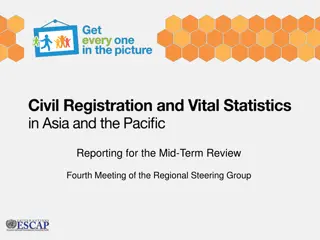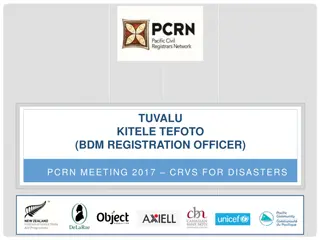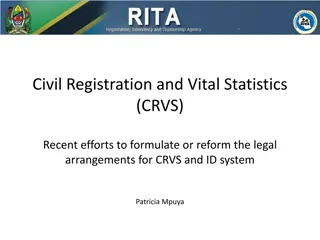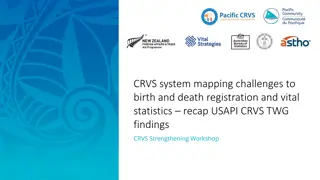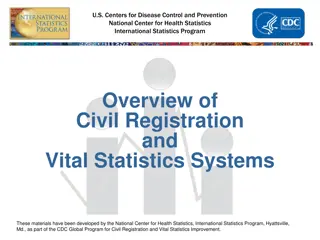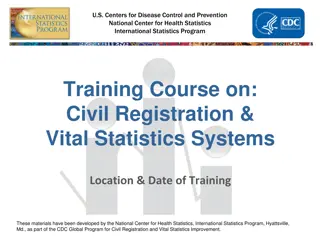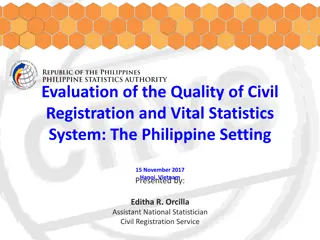Evaluating the quality of vital registration
Focus on death registration, plausibility checks, internal consistency, census methods, age patterns, differentials, urban vs. rural, socio-economic status, international comparisons, and time trends in mortality data quality evaluation.
Download Presentation

Please find below an Image/Link to download the presentation.
The content on the website is provided AS IS for your information and personal use only. It may not be sold, licensed, or shared on other websites without obtaining consent from the author.If you encounter any issues during the download, it is possible that the publisher has removed the file from their server.
You are allowed to download the files provided on this website for personal or commercial use, subject to the condition that they are used lawfully. All files are the property of their respective owners.
The content on the website is provided AS IS for your information and personal use only. It may not be sold, licensed, or shared on other websites without obtaining consent from the author.
E N D
Presentation Transcript
Evaluating the quality of vital registration Focus on death registration Plausibility checks Internal consistency of the data One-census methods Brass Growth Balance Two-census methods General Growth Balance Synthetic Extinct Generation
Patterns in raw mortality data Age patterns Differentials Urban vs. rural Sex Province Socio-economic status International comparisons Time trends
Age patterns Sweden, Males probability of dying, qx 1 0.1 0.01 1900 log scale 1933 1967 2000 0.001 0.0001 0.00001 0 20 40 60 80 100 age x
Age patterns Signs of data quality issues Mortality not uniformly declining during the first few months and years of life Mortality decreasing with age at older ages
Example: Kyrgyzstan Monthly probabilities of death Rural: 1983 .01 .008 .006 dm .004 .002 0 0 5 10 15 20 25 month
Urban/rural differentials Today, in virtually all countries, mortality is lower in urban areas (because of higher education, higher income, better health services, etc.) Reported higher mortality in urban areas is usually due to poor data quality (low coverage in rural areas)
Example: IMR in Kyrgyzstan All ethnic groups 50 40 IMR 30 20 1960 1970 1980 year 1990 2000 urban rural
Mortality regularities Mortality typically higher among males in poorer, less developed provinces among population groups that are less educated, poorer among countries that are less developed Observed mortality patterns that do not follow these patterns indicate potential data quality issues
Time trends Real increases in mortality reflect severe deterioration of socio-economic situation and health care system Observed increases during times of improvements in socio-economic situation are signs of data quality issues (for example, improvement in registration)
Caution Implausible patterns are not always false! Not definite evidence of data quality problem Useful for detecting potential problems Provides guidance for additional analyses
Internal consistency of the data N2 = N1 + B D + I O True for entire population For cohort alive at first census: N2 = N1 D + I O For cohorts born between two censuses N2 = B D + I - O
Consistency of data If estimates of N1, B, D, I, O and N2 agree with one another, the data are consistent If estimates do not agree, error of enclosure -- one or more data sources are biased Without further information on relative quality of sources, difficult to conclude about the source of error By privileging some sources over other sources, it is possible to estimate the amount of error
Example Age 65+ at first census Intercensal period of 10 years N2(75+) = N1(65+) D + I O Assumptions: Census data are reliable I and O well recorded or negligible at these ages (-D + I O) / (N2 N1) = coverage of death registration
Coverage of deaths at ages 65+ Kyrgyzstan
Problems Changes in census coverage Issues with registration of migration Age-misreporting
Brass Growth Balance method Data requirement: Age distribution of the population (e.g., census) Age distribution of deaths during the year of census Main assumptions The population is stable (i.e., fertility and mortality have been constant for the past 70-80 years) No net migration Census coverage is complete Completeness of death registration constant with age
Brass Growth Balance method In any closed population: CGR = CBR CDR In stable populations CGR = CBR(x+) CDR(x+) at any open-ended age interval starting at x CBR(x+) = N(x)/N(x+) CDR(x+) = D(x+)/N(x+) If R = completeness of death registration CBR(x+) = CGR + 1/R * CDR(x+)
Brass Growth Balance method Steps: Calculate N(x) = (5Nx-5+ 5Nx)/10 Calculate CBR(x+) = N(x)/N(x+) for every starting age x Calculate CDR(x+) = D(x+)/N(x+) for every starting age x Plot CBR(x+) against CDR(x+) Regress CBR(x+) against CDR(x+) 1/slope = completeness of death registration Use estimated completeness to calculate adjusted deaths and adjusted mortality indicators
0.120 0.100 0.080 b(x+) 0.060 0.040 0.020 0.000 0.000 0.020 0.040 d(x+) 0.060 0.080 Observations Fit Slope = 1.122 Completeness = 1/1.122 = 89%
Brass Growth Balance Method Remove points at older ages that depart too much from linearity Results sensitive to abrupt departures from stability Especially rapid changes in mortality Will underestimate registration completeness Lower bound for true rate of completeness
General Growth Balance When two censuses are available, no need to assume stability of population Method will work even in presence of rapid changes in mortality and fertility Data requirements Age distribution of population at two successive censuses Age distribution of deaths for intercensal period
General Growth Balance Assumptions Coverage of each census is the same for all ages Completeness of reporting of deaths is the same for all ages from a minimum age (usually age 15) The population is closed to migration Step-by-step IUSSP Excel spreadsheet
Synthetic Extinct Generation Alternative method that uses the same data but somewhat different treatment Full IUSSP Excel worksheet available May use both GGB and SEG. Agreement between the two methods will increase confidence in the results






